Start Date
28-4-2022 10:30 AM
Document Type
Poster
Description
The purpose of the soil and screening plates experiments was to analyze the number of antimicrobials produced by microbes in the sample soil and to test the ability to inhibit other species of bacteria by using the safe relative. The method to test the soil samples by using two natural soil were taken from different areas and serial dilution to calculate the number of cultivable microbes on the plate. Second, isolated some colonies were chosen from the master plate which chose from the soil samples plates to see a possible zone of inhibition by using safe relatives as tester strains and streaked. After screening all the safe relatives and trying almost all my colonies were chosen from my master plate, I identified just one zone inhibition from my second screening plate that chose (Staphylococcus epidermidis) as safe relative to strain it all over the plate. I could not find any other zone inhibition with other safe relatives. Finally, we streaked bacteria to isolate one colony and to determine how active it is. We used the safe relative that is closely related to the ESKAPE pathogens and shares many metabolic characteristics. Since I found one zone inhibition bacteria, the experiments successfully identified antibody-producing microbe.
Soil Sample and Screening
The purpose of the soil and screening plates experiments was to analyze the number of antimicrobials produced by microbes in the sample soil and to test the ability to inhibit other species of bacteria by using the safe relative. The method to test the soil samples by using two natural soil were taken from different areas and serial dilution to calculate the number of cultivable microbes on the plate. Second, isolated some colonies were chosen from the master plate which chose from the soil samples plates to see a possible zone of inhibition by using safe relatives as tester strains and streaked. After screening all the safe relatives and trying almost all my colonies were chosen from my master plate, I identified just one zone inhibition from my second screening plate that chose (Staphylococcus epidermidis) as safe relative to strain it all over the plate. I could not find any other zone inhibition with other safe relatives. Finally, we streaked bacteria to isolate one colony and to determine how active it is. We used the safe relative that is closely related to the ESKAPE pathogens and shares many metabolic characteristics. Since I found one zone inhibition bacteria, the experiments successfully identified antibody-producing microbe.


Comments
The faculty mentor for this project was Rachael Ott, Biology .